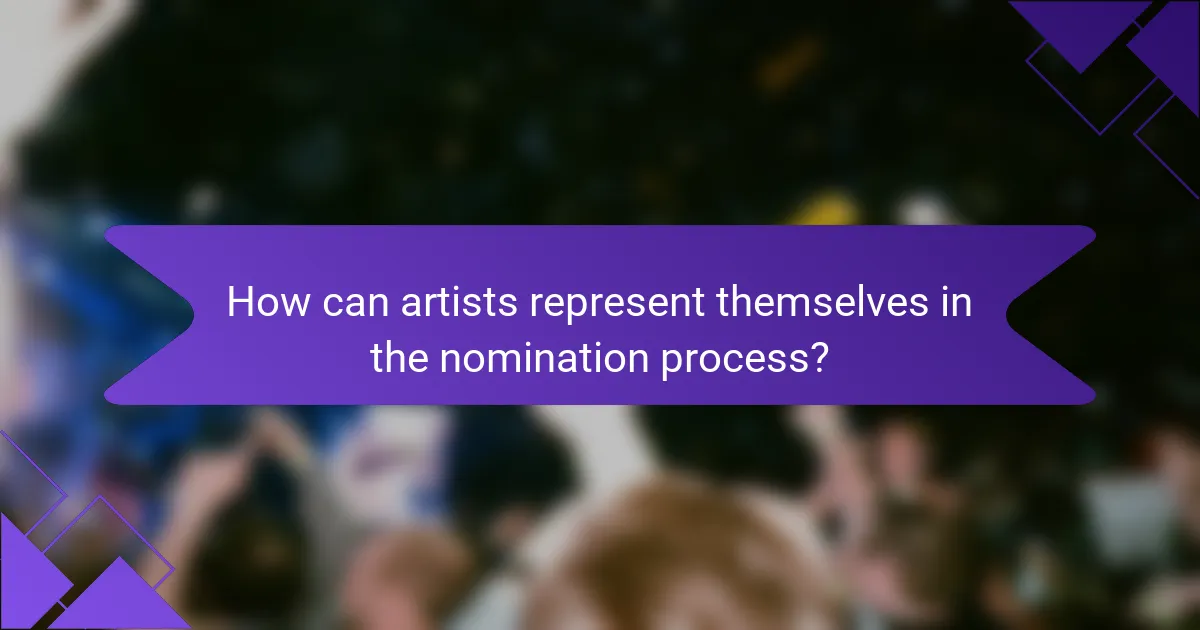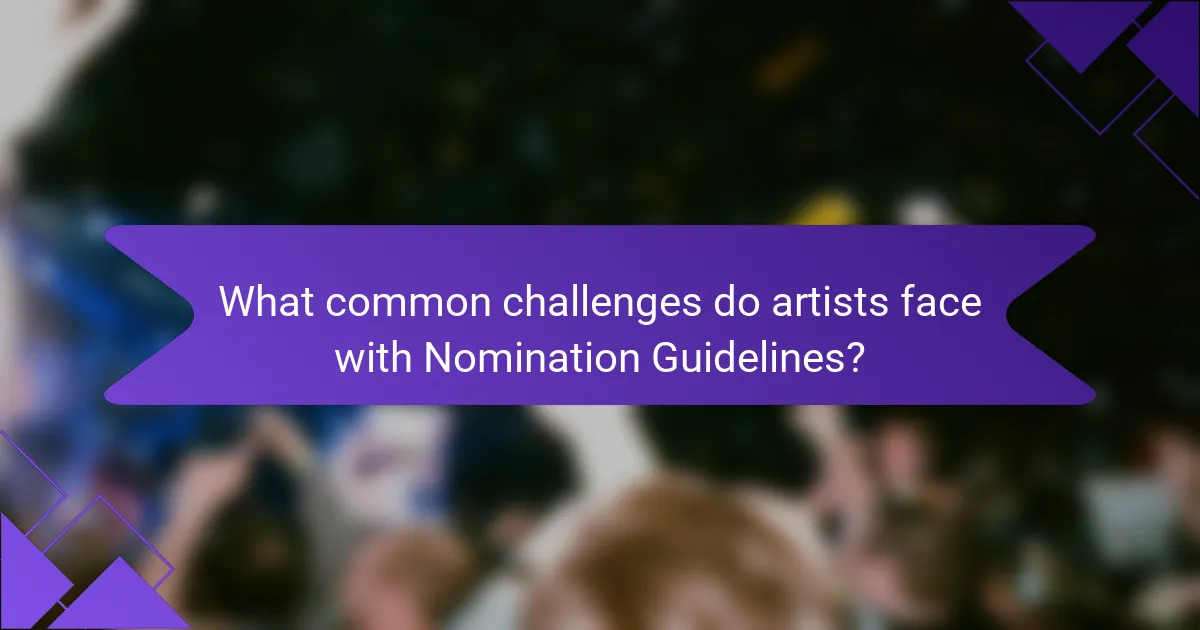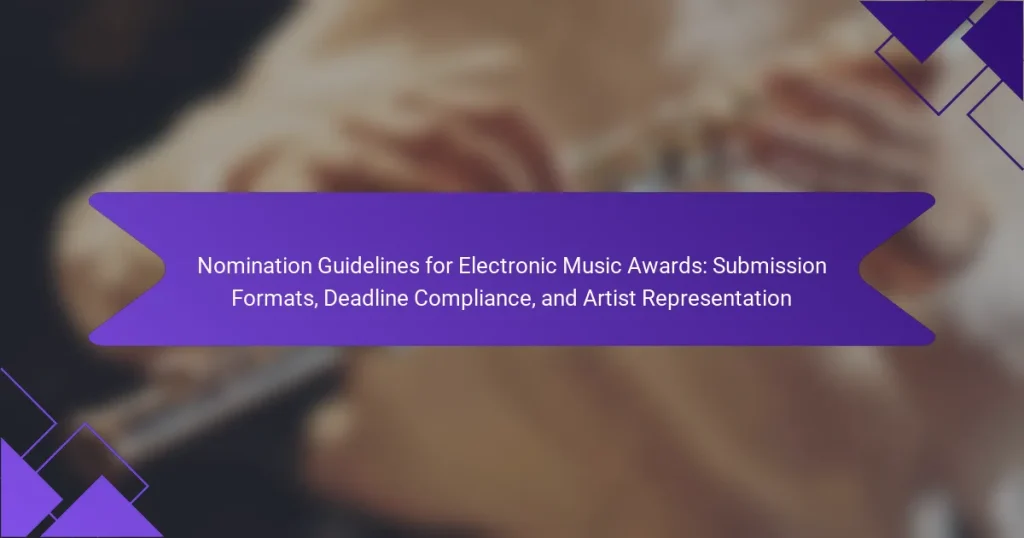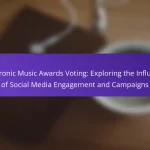The article outlines the Nomination Guidelines for Electronic Music Awards, detailing the criteria for eligible submissions from artists. It specifies that artists must submit original electronic music released within the designated eligibility period, accompanied by a completed nomination form, audio files, and a brief artist biography. The article addresses common challenges artists face, such as understanding submission formats, meeting deadlines, and ensuring proper representation in the nomination process. Additionally, it emphasizes the importance of a comprehensive portfolio and personal statement in enhancing visibility and support within the electronic music community.

What are the Nomination Guidelines for Electronic Music Awards?
The Nomination Guidelines for Electronic Music Awards specify criteria for eligible submissions. Artists must submit original electronic music released within the eligibility period. Submissions should include a completed nomination form and relevant audio files. The deadline for submissions is typically announced annually. Only works meeting the specified genre criteria are eligible. Each submission must be accompanied by a brief artist biography. Additionally, all nominated artists must be available for promotional activities. Compliance with these guidelines ensures fair consideration for all nominees.
Why are Nomination Guidelines important for Electronic Music Awards?
Nomination guidelines are crucial for Electronic Music Awards as they ensure fairness and clarity in the selection process. These guidelines define eligibility criteria, helping to maintain a standard for submissions. They also outline submission formats, which streamline the evaluation process for judges. Adherence to deadlines is enforced through these guidelines, preventing last-minute entries that could disrupt organization. Additionally, they promote transparency by clearly stating how nominees are chosen. This transparency can build trust among artists and fans alike. Overall, nomination guidelines foster a structured environment that enhances the integrity of the awards.
What role do Nomination Guidelines play in the awards process?
Nomination Guidelines establish the framework for submitting entries in the awards process. They define eligibility criteria, ensuring only qualified candidates are considered. Guidelines specify the required formats for submissions, which helps maintain consistency. They also outline deadlines, promoting timely participation from artists. Clear rules in the guidelines prevent confusion and streamline the judging process. By adhering to these guidelines, nominees demonstrate compliance with the awards’ standards. This enhances the integrity of the awards and ensures a fair evaluation of all submissions.
How do Nomination Guidelines ensure fairness and transparency?
Nomination guidelines ensure fairness and transparency by establishing clear criteria for eligibility and evaluation. These guidelines outline specific requirements for submissions, including artistic merit and innovation. They promote equal opportunity by allowing all eligible artists to compete on the same basis. Transparency is achieved through published criteria that are accessible to all participants. Additionally, independent panels often review submissions to minimize bias. Regular audits of the nomination process can further enhance accountability. Overall, these measures create a structured environment where all artists are treated equitably.
What are the key components of the Nomination Guidelines?
The key components of the Nomination Guidelines include submission formats, deadline compliance, and artist representation. Submission formats specify the acceptable file types and quality for entries. Deadline compliance outlines the timeline for submissions, ensuring all entries are received by a specific date. Artist representation requires that nominated artists must be appropriately credited and authorized for the nomination. These components ensure a fair and organized nomination process for the Electronic Music Awards.
What submission formats are accepted for nominations?
Nominations are accepted in various submission formats. These formats typically include digital audio files, such as WAV or MP3. Additionally, video submissions may be accepted in formats like MP4. Each submission format must adhere to specific quality standards. For example, audio files often require a minimum bitrate. Video files may have resolution requirements. These guidelines ensure that all submissions maintain a consistent quality for evaluation.
How should artists prepare their submissions to meet the guidelines?
Artists should prepare their submissions by following the specific guidelines outlined for the Electronic Music Awards. First, they must review the submission formats required, ensuring their work aligns with the specified audio and visual standards. Next, they should adhere to the deadline compliance, submitting their materials well in advance of the cutoff date to avoid disqualification. Additionally, artists should include all necessary documentation, such as artist bios and track information, as required by the guidelines. It is crucial to ensure that the submission is polished and professionally presented. Finally, artists should double-check their entries for completeness and accuracy before submission. These steps increase the likelihood of meeting the guidelines effectively.
What are the deadlines for submitting nominations?
The deadlines for submitting nominations vary by year. Typically, nominations open in early January and close by the end of March. Specific dates are announced on the official Electronic Music Awards website. For the current year, nominations are due by March 31. Late submissions are generally not accepted. It is important to check the official guidelines for any updates or changes.
How can artists ensure they comply with submission deadlines?
Artists can ensure they comply with submission deadlines by creating a detailed timeline. This timeline should outline all key dates leading up to the submission. Artists should prioritize tasks based on their deadlines. They can use digital tools like calendars or project management apps for reminders. Setting personal deadlines before the official ones can also help. Regularly reviewing progress ensures that tasks remain on track. Additionally, artists should communicate with organizers for any clarifications. This proactive approach minimizes last-minute issues.
What happens if a nomination is submitted after the deadline?
Nominations submitted after the deadline are typically disqualified. The Electronic Music Awards have strict submission timelines. Late entries do not undergo review or consideration. This policy ensures fairness among all participants. Adhering to deadlines is crucial for eligibility. The rules are outlined clearly in the nomination guidelines. Compliance with these guidelines is mandatory for all applicants.

How can artists represent themselves in the nomination process?
Artists can represent themselves in the nomination process by submitting a comprehensive portfolio. This portfolio should include their best works, showcasing their unique style and creativity. Artists should also provide a personal statement that reflects their artistic vision and intent. Engaging with the community through social media can enhance visibility and support. Additionally, artists can collaborate with other nominees to broaden their reach. Clear communication of their achievements and contributions to the electronic music scene is essential. All submissions must comply with the specific guidelines set by the awards to ensure eligibility. Following these steps increases the likelihood of a successful nomination.
What are the best practices for artist representation?
Best practices for artist representation include clear communication and mutual understanding. Establishing a contract is essential to outline expectations. Regular updates about opportunities and events keep artists informed. Building a strong online presence enhances visibility. Networking with industry professionals can lead to new opportunities. Providing constructive feedback helps artists grow. Maintaining transparency regarding finances fosters trust. Advocating for the artist’s vision is crucial for their success.
How can artists effectively showcase their work in submissions?
Artists can effectively showcase their work in submissions by presenting high-quality audio and visual materials. Clear and professionally produced audio files enhance the listening experience. High-resolution images or videos of performances can attract attention. Artists should include a concise biography that highlights their background and achievements. A well-written artist statement can provide context for the submitted work. Additionally, following submission guidelines meticulously is crucial for consideration. Research shows that submissions adhering to guidelines have a higher success rate. For example, a study by the National Endowment for the Arts found that clear presentations increase selection chances.
What information should artists include to enhance their representation?
Artists should include a comprehensive biography to enhance their representation. This biography should detail their musical background, influences, and achievements. Artists should also provide high-quality promotional images. These images should reflect their brand and artistic identity. Including links to social media profiles is essential for audience engagement. Artists should share their discography, showcasing their released works. A list of notable performances and collaborations can add credibility. Providing contact information for booking and inquiries is also important. Lastly, a statement of artistic vision can help convey their unique perspective.
How does artist representation affect nomination outcomes?
Artist representation significantly influences nomination outcomes in electronic music awards. A well-represented artist often has access to better resources and industry connections. This can lead to more strategic submissions and increased visibility. For example, artists with strong management teams may receive tailored guidance on nomination processes. Research indicates that representation can enhance promotional efforts, resulting in higher public engagement. Increased engagement often correlates with a greater likelihood of nominations. Additionally, representation can provide artists with insights into industry trends. This knowledge can help them align their work with award criteria, improving their chances of success.
What strategies can artists use to improve their chances of nomination?
Artists can improve their chances of nomination by focusing on quality, networking, and visibility. High-quality music and production are essential. Engaging with industry professionals can create valuable connections. Regularly participating in events increases exposure. Utilizing social media effectively enhances an artist’s presence. Submitting work to multiple awards broadens opportunities. Meeting submission guidelines is crucial for consideration. Researching past nominees can provide insights into successful strategies. Consistent branding helps establish a recognizable identity in the industry.
How important is networking in the nomination process?
Networking is crucial in the nomination process. It facilitates connections with industry peers and influencers. Strong relationships can lead to increased visibility for artists. Networking often results in recommendations from respected figures. These endorsements can significantly influence nomination outcomes. Statistics show that nominees with strong networks have higher chances of winning. Engaging in networking events enhances opportunities for collaboration. Overall, effective networking is a key strategy for success in nominations.

What common challenges do artists face with Nomination Guidelines?
Artists face several common challenges with nomination guidelines. One significant challenge is understanding the specific submission formats required. Many artists struggle to meet the technical specifications outlined in the guidelines. This includes file formats, audio quality, and metadata requirements. Another challenge is adhering to strict deadlines for submissions. Artists often find it difficult to manage their time effectively to meet these deadlines. Additionally, the guidelines may lack clarity, leading to confusion about eligibility criteria. This can result in artists unintentionally disqualifying themselves. Lastly, representation issues arise when artists feel their work is not adequately represented in the nomination process. These challenges can hinder artists’ opportunities for recognition in electronic music awards.
What are the most frequent issues artists encounter during submissions?
Artists frequently encounter issues such as unclear submission guidelines, technical difficulties, and missed deadlines. Unclear guidelines can lead to incorrect formats being used. Technical difficulties may include file size limits or incompatible file types. Many artists also struggle with understanding eligibility criteria. Additionally, last-minute submissions often result in errors. Miscommunication with award organizers can further complicate the process. These challenges can hinder an artist’s chances of successful nomination. Accurate submission practices are essential for maximizing opportunities in award considerations.
How can artists avoid common pitfalls in the nomination process?
Artists can avoid common pitfalls in the nomination process by adhering to specific guidelines. First, they should thoroughly read the nomination criteria. Each award may have unique requirements that must be met. Second, artists must ensure their submissions are complete and accurate. Incomplete submissions can lead to disqualification. Third, they should pay attention to deadlines. Late submissions are typically not accepted. Fourth, artists should present their work professionally. Quality materials reflect their dedication and talent. Finally, networking with past nominees can provide valuable insights. Engaging with others in the industry can enhance their chances of success.
What resources are available to assist artists with the Nomination Guidelines?
Artists can access various resources to assist with the Nomination Guidelines. These include official websites that provide detailed information about the nomination process. Many organizations offer FAQs that address common questions. Additionally, workshops and webinars are often held to guide artists through the submission process. Social media platforms may feature discussions and tips from past nominees. Networking with other artists can also provide valuable insights. Resource links are typically available on the official nomination pages. These resources ensure artists understand the requirements and enhance their chances of successful nominations.
Where can artists find official information on submission formats and deadlines?
Artists can find official information on submission formats and deadlines on the Electronic Music Awards website. This website provides detailed guidelines for submissions. It includes specific formats required for entry. Additionally, the website lists all relevant deadlines for submissions. Artists should regularly check the site for updates. This ensures they have the most current information available. The site is the authoritative source for submission-related inquiries.
What support networks exist for artists navigating the nomination process?
Support networks for artists navigating the nomination process include industry associations, mentorship programs, and online communities. Industry associations, such as the Recording Academy, provide resources and guidance for artists. Mentorship programs connect emerging artists with experienced professionals for advice. Online communities, like social media groups, offer peer support and shared experiences. These networks help artists understand nomination criteria and enhance their visibility. Access to these resources can improve an artist’s chances of successful nominations.
What tips can artists follow to enhance their nomination submissions?
Artists can enhance their nomination submissions by ensuring clarity and professionalism in their materials. Clear and concise descriptions of their work help evaluators understand their artistic vision. Including high-quality audio samples showcases the artist’s sound effectively. A well-organized portfolio highlights achievements and relevant experience. Adhering to submission guidelines is crucial to avoid disqualification. Meeting deadlines shows professionalism and respect for the process. Personalizing the submission with a unique artist statement can make a strong impression. Engaging with the awards community through networking can provide valuable insights.
The main entity of this article is the Nomination Guidelines for Electronic Music Awards, which detail the criteria for eligible submissions in the electronic music genre. The article outlines essential components such as submission formats, compliance with deadlines, and the importance of artist representation in the nomination process. It emphasizes the significance of clear guidelines for ensuring fairness and transparency, while also addressing common challenges artists face during submissions. Additionally, the article provides practical tips and resources to assist artists in successfully navigating the nomination process.


